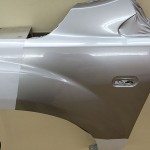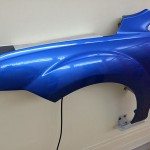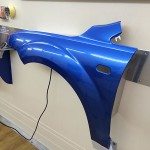For the members of the sign fraternity who know me in my capacity as Director of the BSGA and my 25 years plus experience in the sign industry, they will understand my trepidation when I was invited to attend a UK Sign Group vehicle wrapping course in their mobile training centre when it was visiting PaperlinX in Glasgow. “It will be fun to learn a new skill” didn’t somehow diminish the fear I had of making a complete idiot of myself.
It’s not just the ignominy of air bubbles, creases and holes in the material that I usually leave behind whenever I have attempted to “lay down” some vinyl but it was made worse that I would be doing this in front of some classmates and an instructor. Vinyl application is not my forte.
Looking back with that wonderful attribute of 20/20 hindsight, I was simply acting the wimp purely because no one before had ever bothered to show me how to properly apply vinyl assuming, I myself believe, because any grown up can do it. It got me wondering how many vinyl material sales reps actually have experience in fitting vinyl and can talk about different materials and their properties with confidence. I digress – back to the humiliation!
Actually, the course does no such thing in the way of demeaning the student as with only 6 of us present in the room, we could progress at our own pace and adapt and correct our own skill sets. There will always be the incentive not to be the one at the back of the class but with 6 of us, there is a lot more room for encouragement and support. The trailer unit that has been converted into a class room is ideal for this purpose as not only can the class room come to you, the contents allow you to develop the necessary techniques for practically every shape you will come across when applying vinyl or doing a wrap.
There are two ways of doing it apparently namely the right way and the wrong way and the right way is best summed up in two words – technique and confidence. O.K. plus the right tools for the right job.
We started off gently enough at 9am in the class room with Rob Lambie from UK Sign Group as our tutor but within an hour we were out of the classroom and into the practicals applying different vinyls to an array of different shapes and sizes. I say “we” only in the sense that “we” were in the same room at the same time and with one or two nervous looks over my shoulders at how the rest were getting on, I could see that I had a lot of catching up to do if I were to emulate my classmates.
The amazing thing about this though is that this is the perfect environment to fail in as it is designed to help you work out where you are going wrong and then show you the right way without the worry of possibly damaging someone’s car through inexperience. Anecdotes abound with fitters “25 years in the job” discovering that theirs may not have been the best way to do this sort of thing after all.
Added to all this training was the fact that we were using different vinyl materials and getting a good feel as to the different properties of each film. This is vital in knowing exactly what the right film for the right application is as it cuts down on failure rates which, will inevitably, come back on whoever fitted the material not necessarily those that made the film.
By lunchtime on day one I was happily laying down vinyl on flat and shaped substrates without bubbles or creases and by lunchtime on day two I was able to wrap a whole car body part (in a reasonable amount of time) using 3 or 4 fitting techniques all on one piece of material. By then I had learnt the correct use of knifeless cutting tape thereby avoiding the use of a knife on a car body (a definite no-no), applied vinyl to brick walls, fit around key holes, curves (concave and convex), wing mirrors, bumpers as well as knowing the best way to vinyl wrap a motorbike helmet in one piece.
You could say that I now have the technique and confidence to tackle this sort of application and with a bit more day to day practice, I am certain that I would be able to hold my own against the professionals. I certainly have a lot more admiration and appreciate the value of those that do this sort of thing for a living and do it well without compromise or loss of high standards and quality.
One other thing I learnt and that is if I want a full vehicle wrap, to do it properly will take 2 to 3 days depending on the vehicle and the material itself e.g. if it is a printed wrap or a non-standard material such as chrome or carbon fibre it can take longer than ‘off the shelf’ material. I also now know that there is more money to be made in doing it the long way round instead of cutting corners. The caveat to all this is that there will always be “horses for courses” (and you pay for what you get) but if it were my business, I would be on the lookout for the top end jobs with a greater chance of a bigger and more sustainable profit margin.
Profits aren’t the only thing to consider in this as failures can and will happen and when they do, you need to be contractually prepared. All sorts of stories abound such as perfectly fitted vinyls pulling paint off cars when being removed (the car had had a substandard paint job after an accident not reported at the time the car was wrapped) or the vinyl failing simply because the material was switched to a cheaper variant in order to get more margin out of the price. The BSGA will be issuing a guideline on the very basics of vinyl wrap but it will not be a definitive “how to” guide. The best way of doing that is to attend a course such as this where there is more than one type of material used in the training given by people who have hands on experience.
The course I attended is one that travels around the country and is most likely to be near you sometime soon. For full details go to www.uksgtraining.com to book yourself or your team onto the course.










 European Sign Federation
European Sign Federation